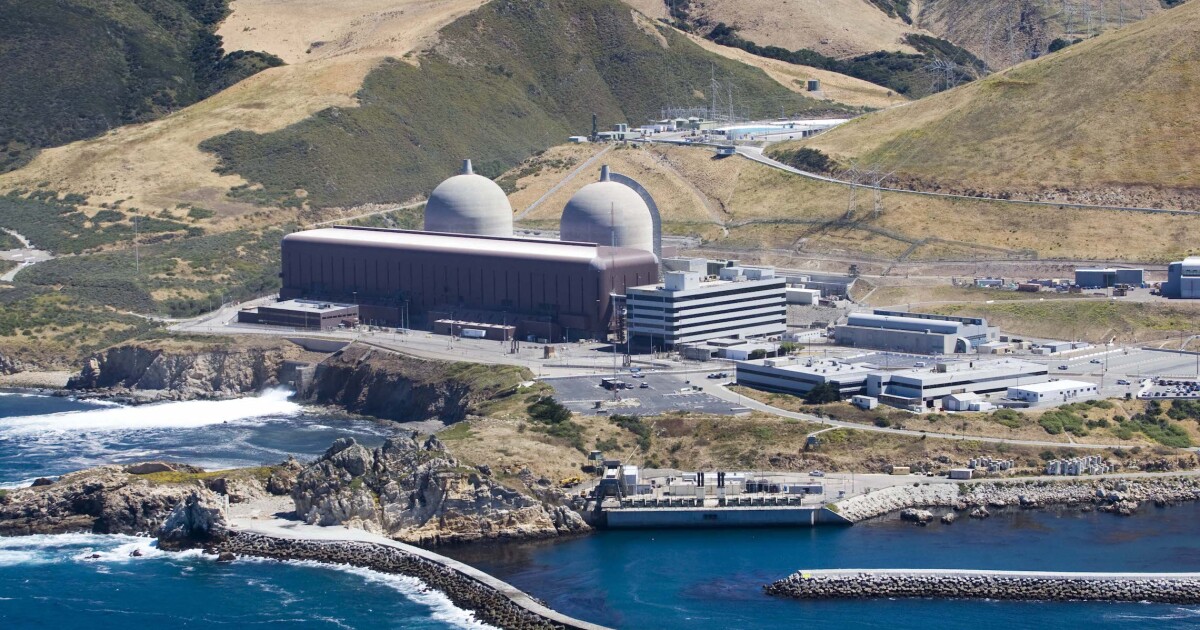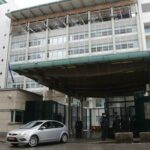

California, bracing for its longest and most intense heat wave of the year, faces the threat of its power grid being pushed beyond capacity and triggering rolling blackouts for the first time since 2020.
Electricity use is expected to climb to a five-year high early next week, regulators said, when demand is expected to peak at around 48,000 megawatts.
The situation has led the state’s Democratic leadership to make a policy 180, supporting efforts to keep fossil-fueled plants online and to extend the life of the state’s last nuclear power plant in the hope of avoiding a shortfall.
Here’s why the grid is being stressed:
DEMAND IS HIGH
California’s grid has been strained due to high heat and severe drought conditions, which drive up its demand for power, largely due to heightened air conditioner use, and limit its ability to produce hydroelectric power.
“On a supply side, we are challenged by these extremes, and on the demand side, not surprisingly, people are turning up the AC,” Gov. Gavin Newsom, a Democrat, told reporters yesterday. “People are understandably trying to escape the heat, so we have to address that twin challenge anew.”
The grid is most strained between 4 p.m. and 9 p.m., when demand is still high but solar power generation decreases. To offset that imbalance, grid operators can call for consumers to conserve electricity voluntarily via its Flex Alert program, which asks residents to turn up their thermostats to at least 78 degrees and to avoid charging electric vehicles or using other large appliances during peak hours of demand.
But some experts said they do not think the alert system provides enough incentive for consumers to reduce demand.
“I am not a believer that we should be doing this through voluntary pleading,” Severin Borenstein, a professor at the University of California, Berkeley’s Haas School of Business and a member of the California ISO Board of Governors, said in an interview. “I think we should have a price system that actually lowers the price most of the time and then raises the price when the system is tight because that would give people the right incentives to conserve power when the system is really tight.”
“Demand response” payments, or payments to customers who temporarily curb their consumption at times of peak demand, are also gaining more traction.
SUPPLY IS CONSTRAINED
Hydropower:
The historic drought conditions and record-low reservoir levels have reduced the state’s ability to generate hydropower by 48%. In-state hydroelectric power fell last year to just 7% of California’s utility-scale net generation, according to data from the U.S. Energy Information Administration, down from nearly 21% in 2017.
That’s not the only effect of heat and drought on the supply of energy. They also exacerbate the risk of wildfires, which can damage transmission infrastructure and can prompt operators to shut off power.
California narrowly avoided such a blackout last summer after the Bootleg Wildfire on the California-Oregon border damaged interstate transmission lines and temporarily halted some electricity imports.
Imports:
Interstate imports are key for California, which receives roughly 25% of its electricity from other Western states, Borenstein, also the faculty director at Haas’s Energy Institute, said in an interview.
But the reliability of these imports has gone down a bit in recent years, due in part to states phasing out coal-fired power plants in the West, as well as the rise of heat waves and drought that have limited their ability to pass along excess resources.
California imports energy from five Western states: Arizona, New Mexico, Nevada, Oregon, and Washington. But these states are also grappling with the same heat and drought conditions as California and have taken many of their own fossil fuel-powered plants offline. Since 2013, these states retired more than 10 gigawatts of fossil fuel generating capacity, leaving them with little excess resources to sell to California.
Operators noted yesterday that four of the five states that supply energy to California are also expecting to be hit by the heat wave, limiting California’s ability to import power.
“We’re monitoring for any potential energy supply shortfalls, and changes in conditions, such as wildfires or generation or transmission outages, that would impact supplies or the grid,” CAISO said in a statement.
The United States is “starting to see these Westwide heat waves” that have restricted states’ ability to sell power to California, Borenstein said. “We used to be able to pretty reliably count on some part of the West having excess capacity they can sell, and that is not as true anymore.”
Renewable energy sources:
California produces a huge amount of renewable energy through wind and solar power and produces more solar power than it can use during the middle of the day. The challenge is in the evening when solar power declines but people are still running their air conditioners, increasing the importance of dispatchable generation assets.
In its annual summer reliability assessment, the North American Electric Reliability Corporation put the entire West at elevated risk for reserve shortages, with regulators warning that the state could face a power shortage of up to 1,700 megawatts on the hottest days.
In addition, operators warned of possible disturbances to the state’s solar photovoltaic, or PV, system, which converts solar into electricity. Disturbances to PV technology “continue to be a reliability concern,” NERC said in its assessment, noting that California experienced four solar PV loss events between June and August 2021.
New renewable battery storage projects for wind and solar could keep that supply online for longer, though so far, California has been unable to match peak summer demand with its increased capacity. (Its battery storage capacity is slated to rise to 6.2 megawatts by the end of 2024.) Supply chain problems have also delayed many solar projects from advancing.
To mitigate supply risks in both the short and long term, planning reserve margins “need to be increased — in some cases significantly — or other actions taken to reduce the probability that demand exceeds resource availability,” the Western Electric Coordinating Council said in a 2021 assessment of resource adequacy.
California has been held up as both a model and a cautionary tale of what can go wrong for states that are looking to phase out their own fossil fuel-powered plants.
A heat storm in August 2020 forced regulators to impose rolling blackouts across the state for the first time in nearly 20 years.
In the two years since, California has added nearly 4,000 megawatts of battery storage.
That’s a “very significant change” in a system forecast to peak at 48,000 megawatts, Borenstein said, noting that the added battery storage is dispatched when the sun is going down and grid demand is the most strained.
“So they are providing a lot of power,” he said. “They’re four-hour batteries, so they can really span a lot of that end-of-day [reliability] problem.”
Nuclear power:
California has backed away from nuclear power in recent years. It closed the San Onofre Nuclear Generating Station, or SONGS, in 2012. A 2016 study published in the American Economic Journal: Applied Economics found that in the 12-month period after the Southern California facility was shuttered, the power it generated was largely replaced by natural gas, increasing emissions and driving up costs for consumers by an estimated $350 million that year alone.
In the 12-month period following the closure of SONGS, researchers found that carbon emissions also rose by 9 million metric tons — the equivalent of putting an additional 2 million gas-consuming cars on the road.
The state is now changing course, though. In August, lawmakers voted to extend the life of the Diablo Canyon nuclear power plant, the last remaining nuclear facility in the state, by an additional five years. The Diablo Canyon facility generates more than 8% of California’s total electricity and 17% of the state’s zero-carbon electricity.
A recent study published by the Brattle Group found that extending Diablo Canyon’s capacity could help California decarbonize “more quickly, more reliably, and at a lower cost” — approximately $5 billion less, in fact — than if the plant shut down in 2025, as previously planned.
To help augment strained grid capacity, California lawmakers also passed a bill this summer granting the state the authority to extend the life of existing fossil fuel-powered plants or to build new or temporary power plants in a supply emergency.
Keeping these fossil fuel plants available for supply emergencies is “very helpful,” Borenstein said. “They are old plants that actually are fairly expensive to run but fairly cheap to keep available. And so the question is, do we want to keep those available? Given that when they do run, they put out a lot of emissions for a gas plant — but we wouldn’t run them very often.”
“And the compromise seems to be, ‘We will keep them available, and we will commit to not running them very often,'” he said.
THE TRADE-OFF
Grid constraints and the rise of extreme heat events have forced leaders in California to walk a fine line between pursuing the state’s ambitious goals on climate and renewable energy and avoiding a supply emergency by turning to readily dispatchable sources of power, such as fossil fueled-plants.
“Paying to keep old resources around as backup for bad days is like buying insurance,” Mark Dyson, a managing director of the carbon-free electricity program at RMI, said in an interview. “You hope you never have to use it.”
Ultimately, he said, “it’s a matter of delivering megawatts to customers during peak events. And the economics of doing that with different kinds of resources should be the primary driver of the decisions to keep or not keep these assets.”
In the long term, Dyson said, “I think we need to recognize that we’re just in a different planning environment than we have been … even just in the last 10 years, with this increasing prevalence of extreme weather. We need to get ahead of that. We need to build, and we need to build the renewable storage and transmission.”
“We need all of those resources to be actually ready for the new climate reality that grids must adapt to in 2022 and beyond,” he added.
“We know reliability is going to be difficult,” Alice Reynolds, president of the California Public Utilities Commission, told reporters at the time. “We know climate change is putting Californians at risk of further outages.”
LOOKING AHEAD
The new subsidies for solar and wind projects provided under the Inflation Reduction Act are set to “dramatically change the cost effectiveness of maintaining old fossil just for reliability versus building something new that’s actually used every day and doesn’t emit carbon,” Dyson said.





